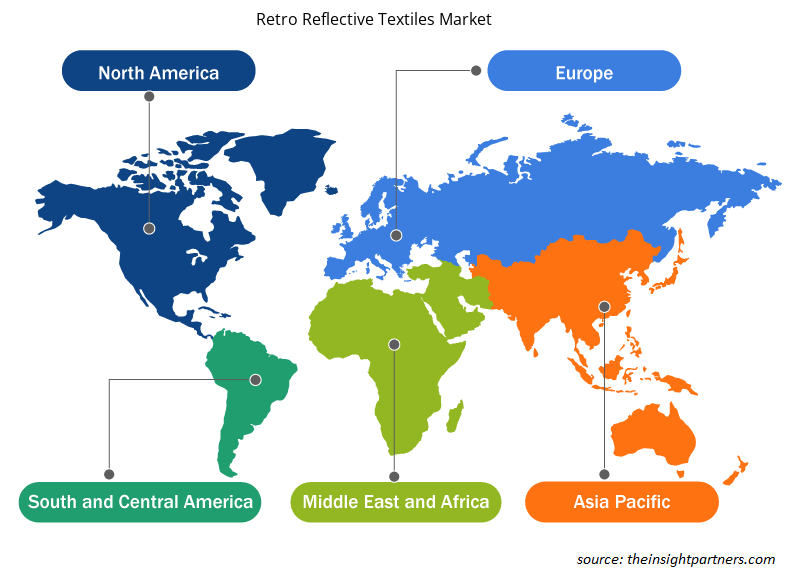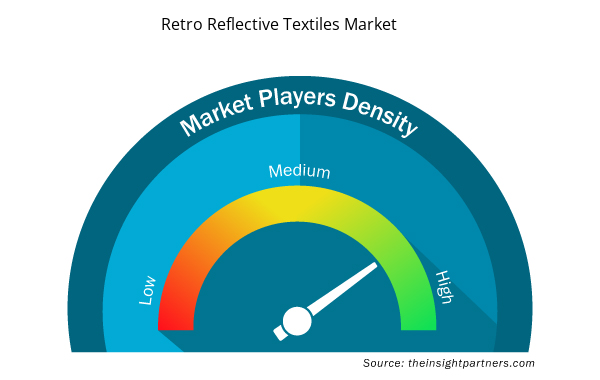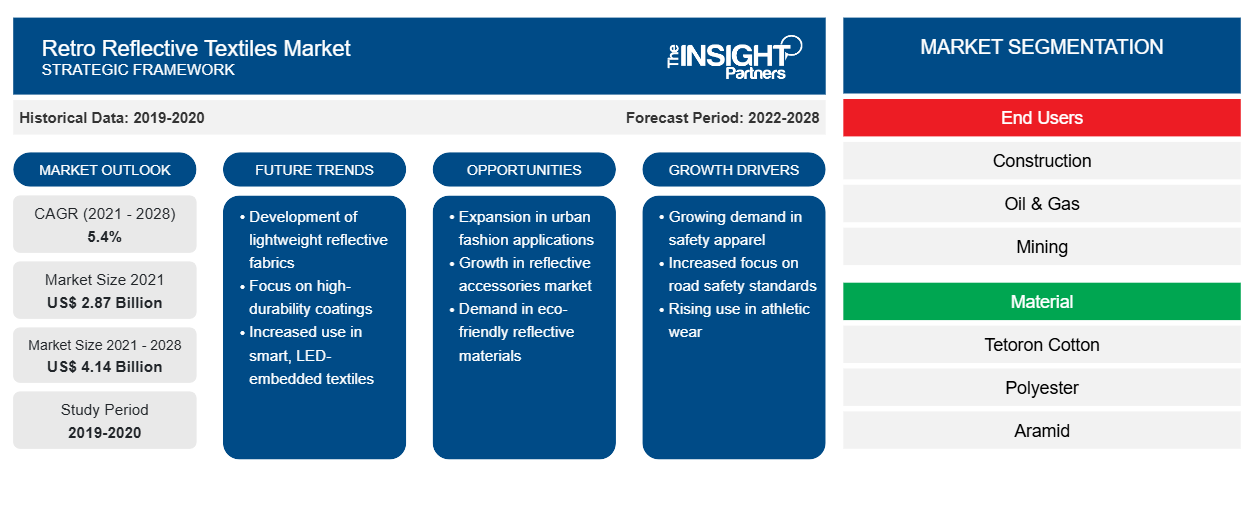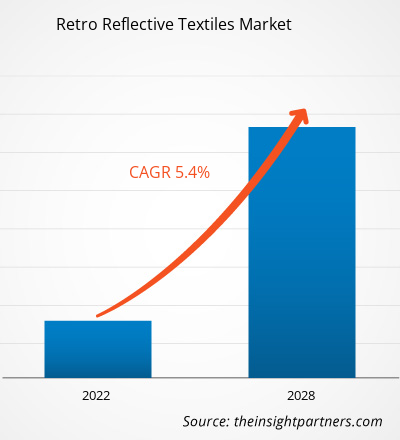[Forschungsbericht] Der Markt für retroreflektierende Textilien soll von 2.872,8 Millionen US-Dollar im Jahr 2021 auf 4.139,8 Millionen US-Dollar im Jahr 2028 wachsen; von 2021 bis 2028 wird mit einer durchschnittlichen jährlichen Wachstumsrate von 5,4 % gerechnet.
Retroreflektierendes Gewebe wird aus kleinen Glasperlen hergestellt, die Licht zurück zur Quelle reflektieren. Es wird häufig für Schutzkleidung in Branchen wie der Bau- und Transportbranche verwendet. Die Nachfrage nach retroreflektierenden Textilien ist aufgrund der Sicherheitsvorschriften verschiedener Regierungen gestiegen. Darüber hinaus hat die wachsende Zahl von Unfällen in den Endverbraucherbranchen wie der Bergbauindustrie die Nachfrage nach retroreflektierenden Textilien angekurbelt.
Im Jahr 2020 hatte der asiatisch-pazifische Raum den größten Anteil am Weltmarkt; es wird geschätzt, dass er im Prognosezeitraum die höchste durchschnittliche jährliche Wachstumsrate verzeichnet. Indien, China und Japan gehören zu den größten Marktteilnehmern. Das hohe Wachstum von Branchen wie Automobil, Transport, Bau und Infrastruktur hatte erhebliche Auswirkungen auf den Markt für retroreflektierende Textilien im asiatisch- pazifischen Raum. Die Bau- und Infrastrukturbranche wächst im asiatisch-pazifischen Raum.
Passen Sie diesen Bericht Ihren Anforderungen an
Sie erhalten kostenlos individuelle Anpassungen an jedem Bericht, einschließlich Teilen dieses Berichts oder einer Analyse auf Länderebene, eines Excel-Datenpakets sowie tolle Angebote und Rabatte für Start-ups und Universitäten.
- Holen Sie sich die wichtigsten Markttrends aus diesem Bericht.Dieses KOSTENLOSE Beispiel umfasst eine Datenanalyse von Markttrends bis hin zu Schätzungen und Prognosen.
Auswirkungen der COVID-19-Pandemie auf den Markt für retroreflektierende Textilien
Im Jahr 2021 begannen die Volkswirtschaften, ihre Aktivitäten wieder anzukurbeln, was sich positiv auf den globalen Markt auswirkte. Die Nachfrage nach retroreflektierenden Textilien wird voraussichtlich auch für verschiedene Anwendungen, wie beispielsweise die Herstellung von Sicherheitskleidung, deutlich steigen. Darüber hinaus können die Hersteller mit voller Kapazität arbeiten, um die Lücke zwischen Angebot und Nachfrage zu schließen. Darüber hinaus sind viele Bürger verschiedener Nationen vollständig geimpft, und die Regierungen verschiedener Länder investieren in die Bau-, Infrastruktur- und Fertigungssektoren. Das Wachstum verschiedener Endverbrauchsbranchen wird voraussichtlich im Prognosezeitraum zu einer hohen Nachfrage nach retroreflektierenden Textilien führen.
Markteinblicke
Wachsende Bedeutung von Arbeitsschutzmaßnahmen und gut sichtbarer Sicherheitskleidung (HVSA)
Unfälle und Todesfälle kommen immer häufiger an Arbeitsplätzen vor, beispielsweise auf Straßen von Baustellen, in der Öl- und Gasindustrie, der chemischen Industrie und im Bergbau, wo schlechte Sicht ein Problem darstellt. In Industriegebieten werden häufig schwere Maschinen, einschließlich Kräne, eingesetzt. Arbeiter ohne Schutzausrüstung sind anfälliger für Unfälle, Verletzungen und Todesfälle, da sie von den Bedienern dieser schweren Maschinen nicht leicht erkannt werden können. Darüber hinaus sind Millionen von Arbeitern anfällig für Unfälle, Überfahren oder Rückwärtsfahren, wenn sie in der Nähe von Verkehr und Baumaschinen arbeiten. Die zunehmende Bedeutung der Sicherheit am Arbeitsplatz wird voraussichtlich das Wachstum des Marktes für retroreflektierende Textilien im Prognosezeitraum vorantreiben.
Erkenntnisse für Endbenutzer
Basierend auf dem Endverbraucher ist der globale Markt in Bauwesen, Öl und Gas, Bergbau, Transport, Feuerwehr, Strafverfolgungsbehörden und andere unterteilt. Im Jahr 2020 hatte das Bauwesen den größten Umsatzanteil; es wird erwartet, dass es im Prognosezeitraum mit der höchsten durchschnittlichen jährlichen Wachstumsrate wächst. Die Baustelle wächst mit der raschen Urbanisierung, was zu vielen thermisch bedingten Umweltproblemen führt, die durch die städtische Wärmeinsel verursacht werden. Diese Reflektoren werden in Schildern, Personalkleidung und Fahrzeugen auf Baustellen verwendet. Retroreflektierende Textilien wurden als innovative Lösung vorgeschlagen, um den für die Kühlung erforderlichen Energiebedarf zu senken und das städtische Mikroklima zu verbessern. Retroreflektierende Textilmaterialien verbessern die Sichtbarkeit und sind unverzichtbare Zubehörmaterialien. Darüber hinaus führte ein rascher Anstieg der Bau- und Infrastrukturaktivitäten zu einem Anstieg der Verwendung von Schildern und Straßenfarbmarkierungen, was das Wachstum des Marktes vorantreibt. Der Haupttreiber des Marktes für retroreflektierende Textilien sind die Großinvestitionen im Bau- und Infrastruktursektor.
3M; Daoming Optics & Chemical Co., Ltd; Hangzhou Chinastars Reflective Material Co.,Ltd; Huangshan Xingwei Reflectorized Material Co., Ltd.; PS ENTERPRISES; Swicofil AG; Unitika Sparklite Ltd.; YGM Reflective; HJ Corp; und HIGHVIZ gehören zu den Akteuren auf dem Markt für retroreflektierende Textilien. Diese Unternehmen bieten dem Markt ein breites Produktportfolio. Die Präsenz dieser Unternehmen in den Entwicklungsregionen bietet lukrative Möglichkeiten für den Markt für retroreflektierende Textilien. Die Marktteilnehmer entwickeln qualitativ hochwertige und innovative Produkte, um die Anforderungen der Kunden zu erfüllen.
Regionale Einblicke in den Markt für retroreflektierende Textilien
Die regionalen Trends und Faktoren, die den Markt für retroreflektierende Textilien während des gesamten Prognosezeitraums beeinflussen, wurden von den Analysten von Insight Partners ausführlich erläutert. In diesem Abschnitt werden auch die Marktsegmente und die Geografie für retroreflektierende Textilien in Nordamerika, Europa, im asiatisch-pazifischen Raum, im Nahen Osten und Afrika sowie in Süd- und Mittelamerika erörtert.

- Holen Sie sich die regionalen Daten für den Markt für retroreflektierende Textilien
Umfang des Marktberichts über retroreflektierende Textilien
| Berichtsattribut | Details |
|---|---|
| Marktgröße im Jahr 2021 | 2,87 Milliarden US-Dollar |
| Marktgröße bis 2028 | 4,14 Milliarden US-Dollar |
| Globale CAGR (2021 - 2028) | 5,4 % |
| Historische Daten | 2019-2020 |
| Prognosezeitraum | 2022–2028 |
| Abgedeckte Segmente | Von Endbenutzern
|
| Abgedeckte Regionen und Länder | NordamerikaAmerica
|
| Marktführer und wichtige Unternehmensprofile |
|
Marktdichte der retroreflektierenden Textilien: Auswirkungen auf die Geschäftsdynamik verstehen
Der Markt für retroreflektierende Textilien wächst rasant, angetrieben durch die steigende Nachfrage der Endverbraucher aufgrund von Faktoren wie sich entwickelnden Verbraucherpräferenzen, technologischen Fortschritten und einem größeren Bewusstsein für die Vorteile des Produkts. Mit steigender Nachfrage erweitern Unternehmen ihr Angebot, entwickeln Innovationen, um die Bedürfnisse der Verbraucher zu erfüllen, und nutzen neue Trends, was das Marktwachstum weiter ankurbelt.
Die Marktteilnehmerdichte bezieht sich auf die Verteilung der Firmen oder Unternehmen, die in einem bestimmten Markt oder einer bestimmten Branche tätig sind. Sie gibt an, wie viele Wettbewerber (Marktteilnehmer) in einem bestimmten Marktraum im Verhältnis zu seiner Größe oder seinem gesamten Marktwert präsent sind.
Die wichtigsten auf dem Markt für retroreflektierende Textilien tätigen Unternehmen sind:
- 3M
- Daoming Optik und Chemie Co., Ltd. Optics and Chemical Co., Ltd
- HANGZHOU CHINASTARS REFLEKTIERENDES MATERIAL CO., LTDCHINASTARS REFLECTIVE MATERIAL CO.,LTD
- Huangshan Xingwei Reflektormaterial Co., Ltd. Xingwei Reflectorized Material Co., Ltd
- PROMOSTY
Haftungsausschluss : Die oben aufgeführten Unternehmen sind nicht in einer bestimmten Reihenfolge aufgeführt.

- Überblick über die wichtigsten Akteure auf dem Markt für retroreflektierende Textilien
Bericht-Spotlights
- Fortschrittliche Branchentrends auf dem Markt helfen den Akteuren bei der Entwicklung wirksamer langfristiger Strategien
- In Industrie- und Entwicklungsländern angewandte Strategien für Unternehmenswachstum
- Quantitative Analyse des Marktes für retroreflektierende Textilien von 2019 bis 2028
- Schätzung der weltweiten Nachfrage nach retroreflektierenden Textilien
- Porters Fünf-Kräfte-Analyse veranschaulicht die Wirksamkeit der in der Branche tätigen Käufer und Lieferanten
- Aktuelle Entwicklungen zum Verständnis des wettbewerbsorientierten Marktszenarios
- Markttrends und -aussichten sowie Faktoren, die das Wachstum des Marktes für retroreflektierende Textilien vorantreiben und bremsen
- Unterstützung im Entscheidungsprozess durch Aufzeigen von Marktstrategien, die das kommerzielle Interesse untermauern und zum Marktwachstum führen
- Die Größe des Marktes an verschiedenen Knotenpunkten
- Detaillierte Übersicht und Segmentierung des Marktes sowie der Dynamik der retroreflektierenden Textilienindustrie
- Größe des Marktes für retroreflektierende Textilien in verschiedenen Regionen mit vielversprechenden Wachstumschancen
Die „Globale Marktanalyse für retroreflektierende Textilien bis 2028“ ist eine spezialisierte und eingehende Studie der Chemie- und Materialindustrie mit besonderem Schwerpunkt auf dem globalen Markt für retroreflektierende Textilien. Der Bericht soll einen Überblick über den Markt mit detaillierter Marktsegmentierung geben. Der Markt für retroreflektierende Textilien ist auf der Grundlage von Endverbrauchern, Material und Geografie segmentiert. Basierend auf den Endverbrauchern ist der Markt für retroreflektierende Textilien in Bauwesen, Öl und Gas, Bergbau, Transport, Feuerwehr, Strafverfolgungsbehörden und andere unterteilt. Basierend auf dem Material ist der Markt in Tetoron-Baumwolle, Polyester, Aramid und andere segmentiert. Nach geografischer Lage ist der Markt für retroreflektierende Textilien grob in Nordamerika, Europa, Asien-Pazifik (APAC), den Nahen Osten und Afrika (MEA) sowie Süd- und Mittelamerika unterteilt.
Firmenprofile
- 3M
- Daoming Optik & Chemie Co., Ltd.
- Hangzhou Chinastars Reflektierendes Material Co., Ltd.
- Huangshan Xingwei Reflektormaterial Co., Ltd.
- PS-UNTERNEHMEN
- Swicofil AG
- Unitika Sparklite Ltd.
- YGM Reflektierend
- HJ Corp
- HIGHVIZ
- Historische Analyse (2 Jahre), Basisjahr, Prognose (7 Jahre) mit CAGR
- PEST- und SWOT-Analyse
- Marktgröße Wert/Volumen – Global, Regional, Land
- Branche und Wettbewerbsumfeld
- Excel-Datensatz



Report Coverage
Revenue forecast, Company Analysis, Industry landscape, Growth factors, and Trends

Segment Covered
This text is related
to segments covered.

Regional Scope
North America, Europe, Asia Pacific, Middle East & Africa, South & Central America

Country Scope
This text is related
to country scope.
Häufig gestellte Fragen
Development of fashion clothing with retro reflective fabric is the key trend for the global retro reflective textiles market. The retro reflective materials are gaining massive traction in the fashion industry. The reflective fabric has become a new fashion trend in recent years, with it being extensively utilized in casual clothing, fashion wear, backpacks, pet jackets, and much more.
Based on end-user, the construction segment led the global retro reflective textiles market in 2020. At construction sites, the worker are required to wear high visibility safety apparel to avoid accidents and help the oncoming traffic to spot them.
Based on the material segment, tetoron cotton is expected to be the fastest-growing segment. The material segment includes tetoron cotton, polyester, aramid and others.
Growing importance of workforce safety measures and high visibility safety apparel (HVSA) along with rising demand from various end-use industries drives the retro reflective textile industry. The primary growth driver identified in the retro reflective textiles market is the large-scale investment in the construction and infrastructure sector. It is anticipated that infrastructural connectivity projects such as the expansion of road and railway networks would generate extensive demand for safety materials used in these projects. The retro reflective textiles market is expected to witness a significant boost in the coming years.
In 2020, Asia Pacific accounted for the largest share of the global retro reflective textiles market. The retro reflective textile industry is anticipated to expand faster due to increasing awareness of work safety clothes and high visibility safety apparel.
The major players operating in the global retro reflective textiles market are 3M; Daoming Optics and Chemical Co., Ltd; HANGZHOU CHINASTARS REFLECTIVE MATERIAL CO., LTD; Huangshan Xingwei Reflectorized Material Co., Ltd; PROMOSTY; PS Enterprises; Shelby Ltd; Swicofil AG; UNITIKA SPARKLITE LTD.; V-Reflex Reflective Material Co., Ltd.
Trends and growth analysis reports related to Chemicals and Materials : READ MORE..
The List of Companies - Retro Reflective Textiles Market
- 3M
- Daoming Optics and Chemical Co., Ltd
- HANGZHOU CHINASTARS REFLECTIVE MATERIAL CO.,LTD
- Huangshan Xingwei Reflectorized Material Co., Ltd
- PROMOSTY
- PS Enterprises
- Shelby Ltd
- Swicofil AG
- UNITIKA SPARKLITE LTD.
- V-Reflex Reflective Material Co., Ltd.
The Insight Partners performs research in 4 major stages: Data Collection & Secondary Research, Primary Research, Data Analysis and Data Triangulation & Final Review.
- Data Collection and Secondary Research:
As a market research and consulting firm operating from a decade, we have published and advised several client across the globe. First step for any study will start with an assessment of currently available data and insights from existing reports. Further, historical and current market information is collected from Investor Presentations, Annual Reports, SEC Filings, etc., and other information related to company’s performance and market positioning are gathered from Paid Databases (Factiva, Hoovers, and Reuters) and various other publications available in public domain.
Several associations trade associates, technical forums, institutes, societies and organization are accessed to gain technical as well as market related insights through their publications such as research papers, blogs and press releases related to the studies are referred to get cues about the market. Further, white papers, journals, magazines, and other news articles published in last 3 years are scrutinized and analyzed to understand the current market trends.
- Primary Research:
The primarily interview analysis comprise of data obtained from industry participants interview and answers to survey questions gathered by in-house primary team.
For primary research, interviews are conducted with industry experts/CEOs/Marketing Managers/VPs/Subject Matter Experts from both demand and supply side to get a 360-degree view of the market. The primary team conducts several interviews based on the complexity of the markets to understand the various market trends and dynamics which makes research more credible and precise.
A typical research interview fulfils the following functions:
- Provides first-hand information on the market size, market trends, growth trends, competitive landscape, and outlook
- Validates and strengthens in-house secondary research findings
- Develops the analysis team’s expertise and market understanding
Primary research involves email interactions and telephone interviews for each market, category, segment, and sub-segment across geographies. The participants who typically take part in such a process include, but are not limited to:
- Industry participants: VPs, business development managers, market intelligence managers and national sales managers
- Outside experts: Valuation experts, research analysts and key opinion leaders specializing in the electronics and semiconductor industry.
Below is the breakup of our primary respondents by company, designation, and region:

Once we receive the confirmation from primary research sources or primary respondents, we finalize the base year market estimation and forecast the data as per the macroeconomic and microeconomic factors assessed during data collection.
- Data Analysis:
Once data is validated through both secondary as well as primary respondents, we finalize the market estimations by hypothesis formulation and factor analysis at regional and country level.
- Macro-Economic Factor Analysis:
We analyse macroeconomic indicators such the gross domestic product (GDP), increase in the demand for goods and services across industries, technological advancement, regional economic growth, governmental policies, the influence of COVID-19, PEST analysis, and other aspects. This analysis aids in setting benchmarks for various nations/regions and approximating market splits. Additionally, the general trend of the aforementioned components aid in determining the market's development possibilities.
- Country Level Data:
Various factors that are especially aligned to the country are taken into account to determine the market size for a certain area and country, including the presence of vendors, such as headquarters and offices, the country's GDP, demand patterns, and industry growth. To comprehend the market dynamics for the nation, a number of growth variables, inhibitors, application areas, and current market trends are researched. The aforementioned elements aid in determining the country's overall market's growth potential.
- Company Profile:
The “Table of Contents” is formulated by listing and analyzing more than 25 - 30 companies operating in the market ecosystem across geographies. However, we profile only 10 companies as a standard practice in our syndicate reports. These 10 companies comprise leading, emerging, and regional players. Nonetheless, our analysis is not restricted to the 10 listed companies, we also analyze other companies present in the market to develop a holistic view and understand the prevailing trends. The “Company Profiles” section in the report covers key facts, business description, products & services, financial information, SWOT analysis, and key developments. The financial information presented is extracted from the annual reports and official documents of the publicly listed companies. Upon collecting the information for the sections of respective companies, we verify them via various primary sources and then compile the data in respective company profiles. The company level information helps us in deriving the base number as well as in forecasting the market size.
- Developing Base Number:
Aggregation of sales statistics (2020-2022) and macro-economic factor, and other secondary and primary research insights are utilized to arrive at base number and related market shares for 2022. The data gaps are identified in this step and relevant market data is analyzed, collected from paid primary interviews or databases. On finalizing the base year market size, forecasts are developed on the basis of macro-economic, industry and market growth factors and company level analysis.
- Data Triangulation and Final Review:
The market findings and base year market size calculations are validated from supply as well as demand side. Demand side validations are based on macro-economic factor analysis and benchmarks for respective regions and countries. In case of supply side validations, revenues of major companies are estimated (in case not available) based on industry benchmark, approximate number of employees, product portfolio, and primary interviews revenues are gathered. Further revenue from target product/service segment is assessed to avoid overshooting of market statistics. In case of heavy deviations between supply and demand side values, all thes steps are repeated to achieve synchronization.
We follow an iterative model, wherein we share our research findings with Subject Matter Experts (SME’s) and Key Opinion Leaders (KOLs) until consensus view of the market is not formulated – this model negates any drastic deviation in the opinions of experts. Only validated and universally acceptable research findings are quoted in our reports.
We have important check points that we use to validate our research findings – which we call – data triangulation, where we validate the information, we generate from secondary sources with primary interviews and then we re-validate with our internal data bases and Subject matter experts. This comprehensive model enables us to deliver high quality, reliable data in shortest possible time.


 Holen Sie sich ein kostenloses Muster für diesen Bericht
Holen Sie sich ein kostenloses Muster für diesen Bericht